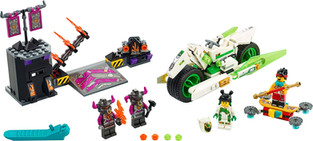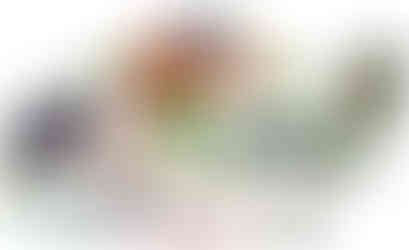Asian Representation in LEGO
- GoldenNinja3000
- Dec 21, 2020
- 6 min read
Updated: Dec 22, 2020
While preparing for the launch of my website, I set out to make my very first LEGO sigfig. A sigfig, or "signature minifigure", is a representation of yourself as a LEGO minifigure. I had never made one before and I knew it would be difficult because very few Indian characters have been represented in LEGO sets, although it's not necessarily LEGO's fault. After all, very few major media franchises have prominent Indian characters, and if they do, they are often walking stereotypes (like Apu in The Simpsons). I think the only fully fleshed-out, well-rounded Indian character I've seen in Hollywood is Cece Parekh in the sitcom New Girl, which isn't the type of property that LEGO would make sets for. LEGO's original themes include minifigures that all have the same yellow skin tone (except for LEGO Friends), so the opportunity to see characters of color is only in sets based on different intellectual properties. I made a video for my YouTube channel about the making of my sigfig, showing the limited range of options for heads in particular, which you can view below.
In this post, I will be exploring overall Asian representation in LEGO. While I focused on Southeast Asia while making my minifigure, it's impossible to solely examine Southeast Asian representation in LEGO properties because it's virtually nonexistent. On the other hand, Chinese and Japanese culture are quite prominent in LEGO, especially over the last few years. This post will examine LEGO Ninjago, which began as a futuristic take on ninja and Japanese culture before becoming more of a mix of Chinese and Japanese influences, before moving onto new LEGO product lines like Monkie Kid and Chinese New Year that directly target Asian consumers.
In the late 1990s and early 2000s, LEGO made sets in the Adventurers and Castle themes that explored different historical cultures for the first time. The subthemes were known as Orient Expedition and Ninja, and are still beloved by many LEGO fans to this day. Ninjago garnered much attention when it debuted in 2011, as it had been over a decade since the original Ninja sets were released.
With the introduction of LEGO Ninjago, an incredible new action/adventure theme was born. Ninjago revolves around a team of ninja protecting their world from a variety of supernatural and technological threats. The setting blends traditional villages with the futuristic Ninjago City, combining traditional elements of Japanese culture with Western civilization. Ninjago has been a massive success for LEGO, lasting far longer than it was originally supposed to. Most original LEGO themes with an accompanying television show only last for three years, like Ninjago's supposed successors, Legends of Chima and Nexo Knights. Ninjago was meant to end with its second season in 2013, but the passionate fanbase and success of its sets led to the theme returning in 2014, and the franchise will celebrate its 10 year anniversary in January.

However, Ninjago has changed quite a bit since its inception. While the cultural influences were overtly Japanese in the beginning, that influence has been toned down in later seasons and elements of Chinese culture have been introduced as well. For example, the leader of the ninja team was originally named Sensei Wu and was called as such for several years. However, in later seasons, he's credited as "Wu", the ninja only refer to him as "master", and the sets now state his name as "Master Wu" instead of sensei. Furthermore, the main character Lloyd uses a Chinese dao broadsword as his weapon of choice from Season 8 onwards, which is when the show underwent a major restructuring to bring it closer to the aesthetic of The LEGO Ninjago Movie, which itself gave Lloyd a Chinese dragon. Most of the architecture in the show is Japanese-inspired, although Ninjago City has always been a mix of Chinese, Japanese, and American architecture, while the written language seen in the show is Japanese. This mix of different cultures makes Ninjago unique, but it also creates a bit of an identity crisis for the series. I think the show's setting has improved since the stylistic changes introduced in Season 8, as Ninjago City now has its own identity with a new chaotic design, helped greatly by the introduction of a brand-new written language originally created for The LEGO Ninjago Movie.
In the last two years, LEGO has made aggressive moves to expand in Chinese markets. They opened dozens of LEGO Stores in China, took counterfeit companies to court, and launched two new themes specifically for Chinese audiences. In 2019, LEGO introduced Chinese New Year, a subtheme of LEGO's seasonal offerings. The two sets, 80101 Chinese New Year's Eve Dinner and 80102 Dragon Dance, were received enthusiastically by LEGO fans all over the world due to their impressive builds, pieces in new colors, exclusive printed parts, and brand-new minifigures wearing authentic Chinese clothing like the qipao. However, backlash erupted when LEGO revealed that the sets would be regional exclusives to the East Asian market, making them impossible to procure for most LEGO fans. This resulted in the death of regional exclusive LEGO sets, and the third 2019 set, 80103 Dragon Boat Race, was available worldwide. In January 2020 LEGO released two further products, 80104 Lion Dance and 80105 Chinese New Year Temple Fair, and the tradition will continue in 2021 with 80106 Story of Nian and 80107 Spring Lantern Festival. These Chinese New Year sets are among the best-designed and most deluxe offerings from LEGO, due to their creative building techniques, abundance of new minifigures, exclusively printed pieces (no stickers anywhere!), and even new part molds for the costumed characters.
Finally, LEGO's most recent push towards the Chinese market has been with the May 2019 launch of LEGO Monkie Kid. Monkie Kid is an original theme with an accompanying television show that is based on the Chinese story Journey to the West, and it operates as a sequel in which the Monkie Kid finds the Monkey King's mythical staff and must battle the Demon Bull King to save the world. The series is a departure from LEGO's usual 3D CGI animation seen in properties like Ninjago, going back to a more traditional 2D hand-drawn style. The concept of the series is similar to Ninjago as it takes place in an almost futuristic setting, and the sets include the kind of builds typical to LEGO's action/adventure themes: large mech robots, transforming, oversized vehicles, and lots of transparent colors and shooting projectiles. The Monkey King, Pigsy, and Sandy return from the original legend, while Monkie Kid's friend Mei is a descendant of the White Dragon Horse. Mei drives a White Dragon Horse motorcycle and wears a motorcycle suit outfit inspired by her ancestor, featuring a white design with a green dragon and gold accents. Monkie Kid had one of the biggest launches for a LEGO theme, with the release of eight sets that ranged in price from $35 to $170. Four of the sets had over 1,000 pieces, which, coupled with the high prices, drew lots of attention. No other LEGO theme has ever launched with so many large and expensive sets, and while many fans felt that the theme was a bit overpriced, the sets are quite unique given that this is the first time LEGO has explicitly targeted a new market in this manner.
LEGO has made a great push for diversity in the last few years in its efforts to target Chinese consumers. However, it would be great to see a similar level of care applied to other cultures, especially those in Southeast Asia. There are very few Indian and Pakistani LEGO minifigures, although this is also primarily due to the lack of Southeast Asian characters in major franchises like Star Wars, the Marvel Cinematic Universe, and the Wizarding World, three properties that get many new sets each year. In my video, I cover the only minifigures LEGO has made for these communities, which include Simon Masrani (Jurassic World), Kamala Khan/Ms. Marvel (Marvel Comics), and Parvati and Padma Patil (Wizarding World). Hopefully we will see more characters of color represented in toys as franchises diversify further (especially the MCU), although it would be great to see LEGO introduce an Indian or Pakistani character in LEGO Friends, which doesn't use the typical LEGO yellow skin tone and has included African-American, East Asian, and Latina figures over the last eight years.











































